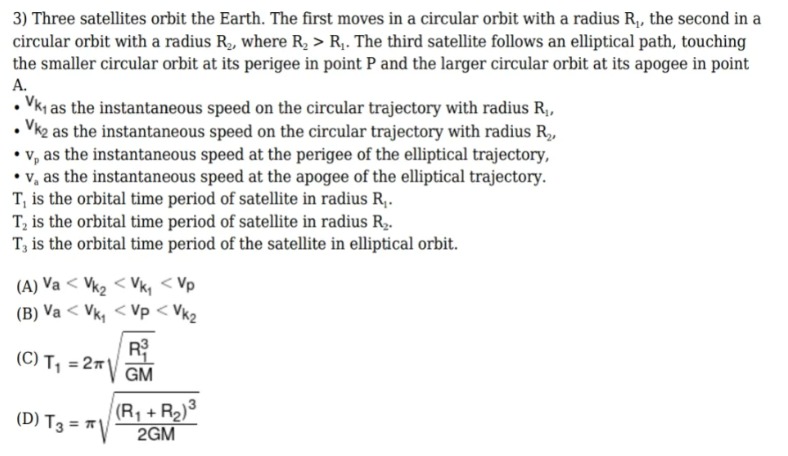Question
Question: Three satellites orbit the Earth. The first moves in a circular orbit with a radius R₁, the second i...
Three satellites orbit the Earth. The first moves in a circular orbit with a radius R₁, the second in a circular orbit with a radius R₂, where R₂ > R₁. The third satellite follows an elliptical path, touching the smaller circular orbit at its perigee in point P and the larger circular orbit at its apogee in point A.
- Vk1 as the instantaneous speed on the circular trajectory with radius R₁,
- Vk2 as the instantaneous speed on the circular trajectory with radius R₂,
- Vp as the instantaneous speed at the perigee of the elliptical trajectory,
- Va as the instantaneous speed at the apogee of the elliptical trajectory.
T1 is the orbital time period of satellite in radius R₁. T2 is the orbital time period of satellite in radius R₂. T3 is the orbital time period of the satellite in elliptical orbit.

Va<Vk2<Vk1<Vp
Va<Vk1<Vp<Vk2
T1=2πGMR13
T3=π2GM(R1+R2)3
A, C, D
Solution
The question asks us to compare the speeds of three satellites orbiting the Earth and to provide expressions for their time periods.
Let G be the gravitational constant and M be the mass of the Earth.
For a satellite in a circular orbit of radius r, the speed is given by vk=rGM. The period of a circular orbit is T=vk2πr=2πrGMr=2πGMr3.
For the first satellite in a circular orbit with radius R1, the speed is Vk1=R1GM. The time period is T1=2πGMR13.
For the second satellite in a circular orbit with radius R2, the speed is Vk2=R2GM. Since R2>R1, we have R21<R11, so Vk2<Vk1.
For the third satellite in an elliptical orbit, the perigee is at R1 and the apogee is at R2. The speed at perigee is Vp and the speed at apogee is Va. The semi-major axis of the elliptical orbit is a=2R1+R2. According to Kepler's third law, the period of the elliptical orbit is T3=2πGMa3=2πGM(2R1+R2)3=2π8GM(R1+R2)3=π2GM(R1+R2)3.
Using conservation of energy and angular momentum for the elliptical orbit:
Energy at perigee = Energy at apogee: 21mVp2−R1GMm=21mVa2−R2GMm
Angular momentum at perigee = Angular momentum at apogee: mR1Vp=mR2Va, so Va=R2R1Vp.
Substituting Va into the energy equation:
21Vp2−R1GM=21(R2R1Vp)2−R2GM
21Vp2(1−R22R12)=GM(R11−R21)
21Vp2(R22R22−R12)=GM(R1R2R2−R1)
Vp2=R1R22GMR1+R2R22=R1(R1+R2)2GMR2
Vp=R1(R1+R2)2GMR2
Va=R2R1Vp=R2R1R1(R1+R2)2GMR2=R2(R1+R2)2GMR1
Comparing speeds:
Vp2=R1(R1+R2)2GMR2 and Vk12=R1GM. Vk12Vp2=R1+R22R2. Since R2>R1, R1+R2<2R2, so R1+R22R2>1. Thus Vp>Vk1.
Va2=R2(R1+R2)2GMR1 and Vk22=R2GM. Vk22Va2=R1+R22R1. Since R2>R1, R1+R2>2R1, so R1+R22R1<1. Thus Va<Vk2.
We already have Vk2<Vk1.
Also, from R1Vp=R2Va and R2>R1, we have Vp>Va.
Combining the inequalities: Va<Vk2<Vk1<Vp.
Therefore, options (A), (C), and (D) are correct.
